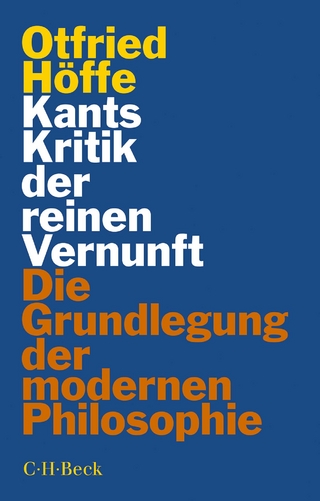
Making Sense of Kant's “Critique of Pure Reason”
Bloomsbury Academic (Verlag)
978-1-350-25477-0 (ISBN)
The guiding assumptions of the book are that Kant is a humanist; that his reasoning in the Critique is driven by an interest in human knowledge and the cognitive capacities that underlie it; and that he is not a skeptic, but accepts that human beings have objective knowledge and seeks to explain how this is possible. Pendlebury provides an integrated and accessible account of Kant’s explanation that will help those who are new to the Critique make sense of it.
Michael Pendlebury is Professor of Philosophy and Head of the Department of Philosophy and Religious Studies, North Carolina State University, USA.
Preface
How to Use This Book
Note on Citations of and Quotations from Kant’s Works
1. Background
1.1 The Basic Structure of Our World
1.2 Knowledge and Reality
1.3 The Critique of Pure Reason
2 The Preface and the Introduction: Two Types of Metaphysics
2.1 A Science of Metaphysics? (Bvii–xxxi)
2.2 A Priori Cognition (B1–10)
2.3 The Analytic/Synthetic Distinction (B10–12)
2.4 Synthetic a Priori Judgments and Knowledge (B12–24)
2.5 Transcendental Philosophy (B24–7)
3 The Transcendental Aesthetic: Sensibility, Space, and Time
3.1 Intuitions, Appearances, and the Forms of Sensibility (B33–7)
3.2 The Presentation of Space (B37–41)
3.3 The Reality of Space (B42–5)
3.4 The Presentation and Reality of Time (B46–58)
4 The Metaphysical Deduction: Judgments, Concepts, and Categories
4.1 Sensibility and Understanding (B74–6)
4.2 Concepts and Judgments (B91–4)
4.3 Forms of Judgment and Categories (B95–101 and 106–13)
4.4 Synthesis (B102–5)
5 The Analogies and the Postulates: Fundamental Principles about Substance, Causation, Community, and Modality
5.1 The System of Principles (B187–9, 193–203, and 207–8)
5.2 Experience and Objectivity (B218–24)
5.3 The First Analogy: Substance (B224–32)
5.4 The Second Analogy: Causation (B232–56)
5.5 The Third Analogy: Community (B256–62)
5.6 The Postulates: Possibility, Actuality, and Necessity (B265–74 and 279–82)
5.7 The Unity of Nature (B263–5)
6 The Transcendental Deduction: Why Intuitions Fall Under Categories
6.1 The Challenge (B116–29)
6.2 Apperception and Judgment: Why Intuitions Must Fall Under Categories (B129–43)
6.3 Interlude (B144–9 and 152–9)
6.4 Figurative Synthesis: Why Intuitions Can Fall Under Categories (B150–2 and 159–69)
6.5 Dreams, Hallucinations, and Seemings
7 The Schematism: How Intuitions Fall Under Categories (B176–87)
7.1 Transcendental Schemata as Criteria
7.2 Sensible and Empirical Schemata and the Synthesis of Imagination
7.3 Transcendental Schemata as Forms of Imaginative Synthesis
7.4 An Overview of Kant’s Account of Synthetic a Priori Knowledge
8 The Dialectic: The Limits of Speculative Reason
8.1 Ideas and Illusions (B368–75 and 390–3)
8.2 The Paralogisms: The Soul (B399–415 and 421–8)
8.3 The Antinomy: Nature (B432–48, 525–35, and 556–60)
8.4 The First Antinomy: The Limits of Nature (B454–7 and 545–51)
8.5 The Second Antinomy: The Divisibility of Substance (B462–5 and 551–5)
8.6 The Third Antinomy: Freedom and the Laws of Nature (B472–5 and 560–86)
8.7 The Fourth Antinomy: The Necessity of Nature (B480–3 and 587–95)
8.8 The Ideal: God (B595–619, 624–9, 632–4, 637–8, and 653–6)
8.9 The Regulative Function of Ideas (B670–9, 536–7, 644–8, and 708–16)
9 Taking Stock
9.1 Transcendental Idealism and Things in Themselves (B274–9 and 288–94)
9.2 Kant’s Achievement
Notes
Bibliography
Index of Citations of Passages in the Critique of Pure Reason
Index of Subjects and Names
| Erscheinungsdatum | 15.07.2022 |
|---|---|
| Verlagsort | London |
| Sprache | englisch |
| Maße | 138 x 216 mm |
| Themenwelt | Geisteswissenschaften ► Philosophie ► Erkenntnistheorie / Wissenschaftstheorie |
| Geisteswissenschaften ► Philosophie ► Metaphysik / Ontologie | |
| Geisteswissenschaften ► Religion / Theologie | |
| ISBN-10 | 1-350-25477-0 / 1350254770 |
| ISBN-13 | 978-1-350-25477-0 / 9781350254770 |
| Zustand | Neuware |
| Informationen gemäß Produktsicherheitsverordnung (GPSR) | |
| Haben Sie eine Frage zum Produkt? |
aus dem Bereich

![Was heißt Denken?. Vorlesung Wintersemester 1951/52. [Was bedeutet das alles?] - Martin Heidegger](/media/113619842)
